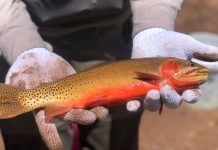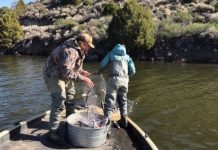URBANA-CHAMPAGNE, Ill., Nov. 18 (UPI/Brooks Hays) ─ CO2 bubbles have a disorienting effect on tiny Asian carp fry, deterring them from invading new territory.
Fry are tiny juvenile fish. University of Illinois researcher Cory Suski had already proved CO2’s bewildering power over adults. Now it’s clear migrating offspring are turned back by the bubbles too.
“We conducted carbon dioxide challenge experiments on juveniles of four species -largemouth bass, bluegill, silver carp, and bighead carp, and on eight-day-old hatched fry of both carp species,” Suski said in a press release.
“Results from the study demonstrate that juvenile fishes of all four species actively avoid areas of water with elevated CO2 once concentrations reached approximately 200 milligrams per liter, which is lower than a can of carbonated soda.”
The carp fry are the size of an eyelash, making them near impossible to observe visually. Instead, Suski and his research partners look at gene expression to infer behavior.
“Even at only eight days old, there are physiological problems happening to those animals when they are put into a high CO2 environment,” he explained. “The biomarkers of stress turned on. So we now have evidence all the way from large adult fish to eight-day-old fish that CO2 causes disturbance.”
Suski acknowledges that like other non-physical barriers, CO2 bubbles aren’t 100 percent effective. But CO2 deterrence poses no safety risks. Suski thinks the technology should be employed in tandem with electric barriers.
Hoses could carry CO2 into backwater inlets where Asian carp are known to spawn. Such setups would use recycled carbon dioxide, Suski promised, not newly generated gas.
“The suppliers we have used to date have obtained waste CO2 from oil and gas refineries or from soybean processing plants so we’re not smelting coal to generate carbon dioxide,” he explained. “We’re taking waste CO2 and repurposing it.”
CO2’s effects on Asian carp were recently detailed in the journal Biological Invasions.





